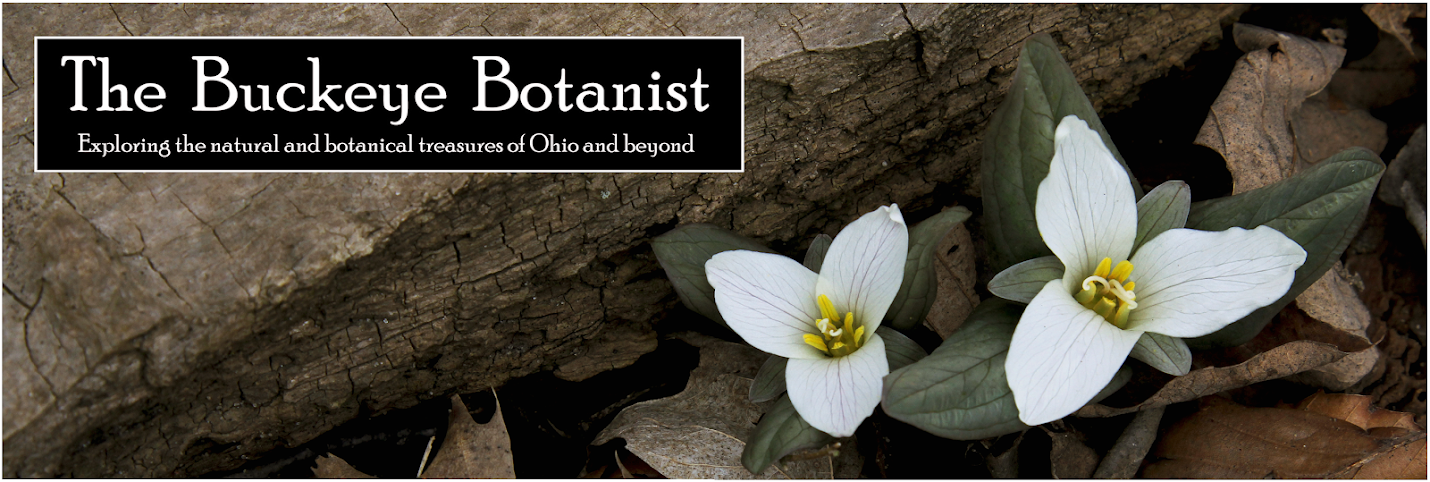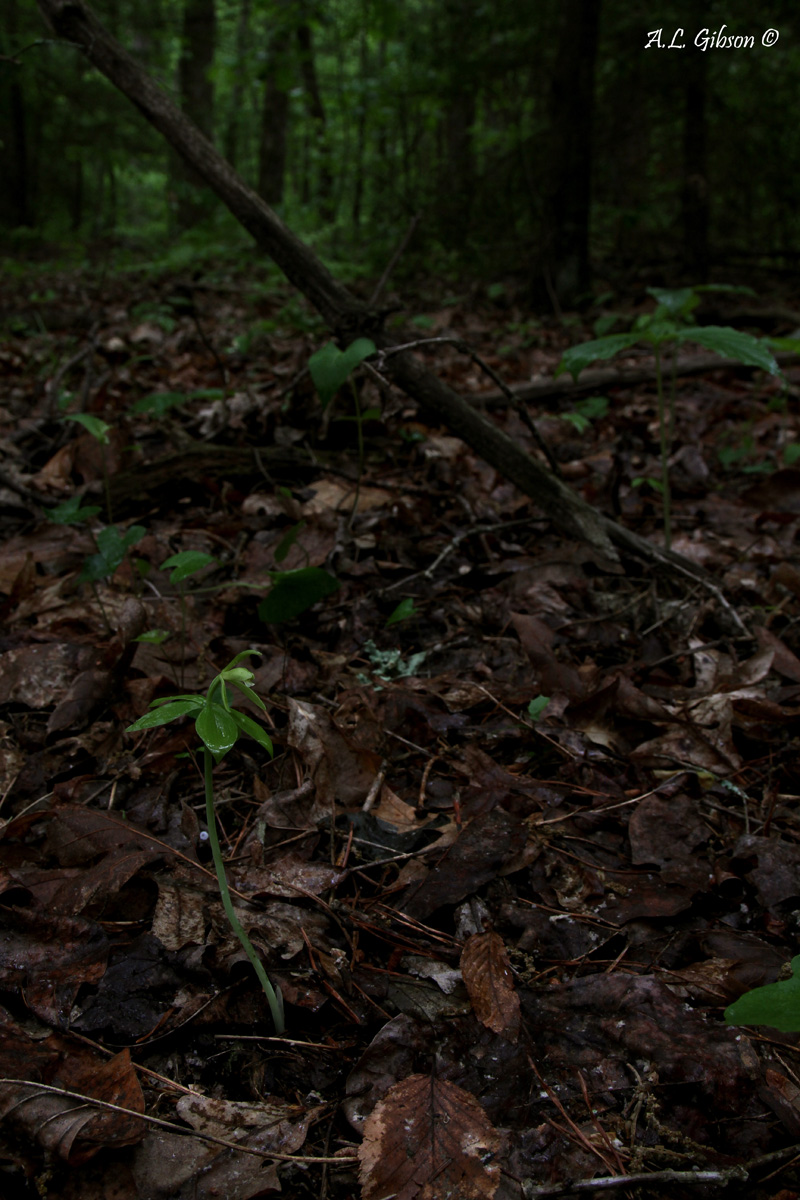Whew. Here it is the last day in May and I have no idea where the time has gone. It seems like just last week I was admiring the reemergence of snow trillium and the slew of spring ephemerals to follow and in the blink of an eye they are done and gone until next spring. Working full time during the week along with my weekends filled with events, conferences, and road trips has left your blogger exhausted and in desperate need of a breather but I really can't complain as I've enjoyed each and every minute of it.
To truly capture the mood and colors of the month of May, I'd need a dozen separate blog posts, so in the interest of saving time and taking advantage of the remaining energy I have, here's a photogenic ensemble of some of my favorite wildflowers and plants from this past month. There's no real rhyme or reason to what I've decided to share other than they are all species you can find in our fine state of Ohio as spring swings into summer.
 |
| Tuliptree (Liriodendron tuliptera) |
Few, if any other native tree in our state has as showy and spectacular a floral show as the stately tuliptree (
Liriodendron tulipifera). Despite being an incredibly common tree throughout the state, few get the chance to see their stunning show as their flowers are often out of sight and out of mind in the canopy above. The tuliptree has the distinction of being the tallest deciduous tree east of the Mississippi, with some specimens topping out at over 200 feet tall in the primeval forests.
 |
| Wherry's Catchfly (Silene caroliniana var. wherryi) |
One of my most anticipated of late spring's wildflower shows is the annual explosion of pink from the state threatened Wherry's catchfly (
Silene caroliniana var. wherryi). They are certainly hard to miss when blooming en masse along select hillsides of exposed Ohio shale bedrock in the Adams county area.
 |
| Puttyroot pale form (forma pallidum) |
 |
| Puttyroot Orchid (Aplectrum hyemale) |
Despite being one of Ohio's more common species of orchid, the puttyroot (
Aplectrum hyemale) is a specialist in camouflage and blending in and thus not something many get to see in flower. To make matters even more complicated, it can be a fickle bloomer from year to year and you just never know when a plant will decide to send forth its flowering culm. An almost alien-looking lemon-lime colored form occurs sporadically as well throughout the state.
 |
| Guyandotte Beauty (Synandra hispidula) |
One of my favorite aspects of this blog is getting the opportunity to share and introduce my readers to wildflowers and plant species they potentially didn't even know existed. The stunning guyandotte beauty or sometimes simply called synandra (
Synandra hispidula) is one that I think fits that bill. It's rather uncommon throughout the southern half of the state and was once included on our rare plant list. It hails from the mint family (
Lamiaceae) and is one of my absolute favorites.
 |
| Trumpet Honeysuckle (Lonicera sempervirens) |
When the word 'honeysuckle' is mentioned among the ecological savvy, thoughts of hatred and malevolence quickly arise and rightfully so as many members of the
Lonicera genus stand as one of our greatest invasive species threats but let's not be too quick to judge as there are a handful of native honeysuckles (all vines) that deserve our attention and good tidings. My favorite is the trumpet honeysuckle (
L. sempervirens) which some Ohio botanists will argue isn't truly indigenous to our state, which is something I don't fully agree with. Regardless, its rich and bold color certainly stands out when in full flower.
 |
| Fringe Tree (Chionanthus virginicus) |
 |
| Fringe Tree (Chionanthus virginicus) |
The woody plants or our trees, shrubs, and vines were my first botanical love and few get me more excited than the rare fringe tree (
Chionanthus virginicus) in full glorious bloom. Typically a multi-trunked shrub or small tree, this relative to our ash trees (
Fraxinus spp.) only occurs in a handful or so of our southernmost counties. This is the epitome of a "boom or bust" plant as it's quite easily picked out when in flower but is nigh on impossible to detect when purely in its vegetative state.
 |
| Crossvine (Bignonia capreolata) |
From one of my favorite shrubs to one of my favorite vines in the crossvine (
Bignonia capreolata). This relative to the much more common and weedy trumpet creeper (
Campsis radicans) is largely restricted to the river counties along the Ohio River and is rather local in its distribution. This particular patch has made quite a home for itself on a sheer rock face overlooking the mighty Ohio River.
 |
| An assortment of spring wildflowers in a limestone barrens in Adams county |
Prairies are typically thought of as summer and fall attractions and that mindset is certainly not wrong but you'd be missing out on some spectacular flora if you only paid attention to them during those seasons. Down Adams county way in its famed dolomite limestone barrens and glades, spring can be just as exciting a time to visit when the browns and grays give way to bouquets of new life. Wildflowers like prairie phlox (
Phlox pilosa), scarlet paintbrush (
Castilleja coccinea), hoary puccoon (
Lithospermum canescens), white blue-eyed grass (
Sisyrinchium albidum), and heart-leaved Alexanders (
Zizia aptera) dot the landscape in their respective shades of pink, red, yellow, and white.
 |
| Flame Azalea (Rhododendron calendulaceum) |
It just wouldn't be May without some fire-orange blossoms from the flame azalea (
Rhododendron calendulaceum), at least in my book. There's just something about the way their color explodes off the branches and catches the eye. It's unfortunate this species is so rare in Ohio and only occurs in a few naturally-occurring populations, as it definitely deserves a spot in anyone's landscaping let alone Mother Nature's.
 |
| Umbrella Magnolia (Magnolia tripetala) |
 |
| Umbrella Magnolia (Magnolia tripetala) |
Before you accuse me of cheating and using a species from the tropics, let me assure you the wondrous leaves and flowers of the umbrella magnolia (
Magnolia tripetala) is indeed native to Ohio and right at home here in our northern-ish state. Much more common further south, this species barely made it into Ohio, where it most frequently occurs in the southernmost counties and is more than likely here thanks to the influential Teay's River millions of years ago.
 |
| Vernal Iris (Iris verna) |
The rare and state threatened vernal iris (
Iris verna) is one that I anxiously await every early May in the dry, acidic slopes and ridges of Shawnee state forest. There's just something about its electric purple-blue color and vibrant spear-shaped green leaves that set it apart from so many others. Seeing a whole hillside ensconced in this scarcity during peak flower is sure to impress and wow even the most apathetic of by passers.
 |
| Wild Hyacinth (Camassia scilloides) |
The lushness of the spring time is perhaps best captured by the succulence of a thick patch of wild hyacinth (
Camassia scilloides). It's by no means a rare or uncommon occurrence but they always make me stop in my tracks anytime I see an especially impressive display. Their short-lived flowers match the fleeting nature of spring to a tee as well.
 |
| American Ginseng (Panax quinquefolius) |
While not a spring bloomer nor an attractive bloomer when it does do its thing, it's always a pleasure to come across a small colony or even a lone plant of the increasingly uncommon American ginseng (
Panax quinquefolius). Some take pleasure in hunting this herb down for its root's medicinal value and worth but I get my pleasure and worth out of just seeing it still occur in wild areas across the state.
 |
| Drooping Sedge (Carex prasina) |
I'd be remiss if I didn't include at least one spring flowering sedge in this post. The drooping sedge (
Carex prasina) is one of the more graceful and aesthetic of our sedges and is a lovely sight to see when growing in dense clumps along forested seeps and springs. Spring is just as exciting a time for self-diagnosed sedge-heads like me as for the wildflower and birding aficionados.
 |
| Lance-leaved Violet (Viola lanceolata) |
Rounding out this post is one of Ohio's nearly 30 species of violets in the rare lance-leaved violet (
Viola lanceolata). Along with orchids, milkweeds, and trilliums, the violets are one of my favorite plant families to study and photograph in the wild. They can be a difficult and frustrating group but that's half the fun...or at least I'd like to think so.
Hope you've enjoyed this slideshow-esque post on some of my favorite spring wildflowers and plants and I certainly hope to bring you more of summer and fall's bloomers as time inexorably marches forward and leaves us all wondering where the time and days went.




























































